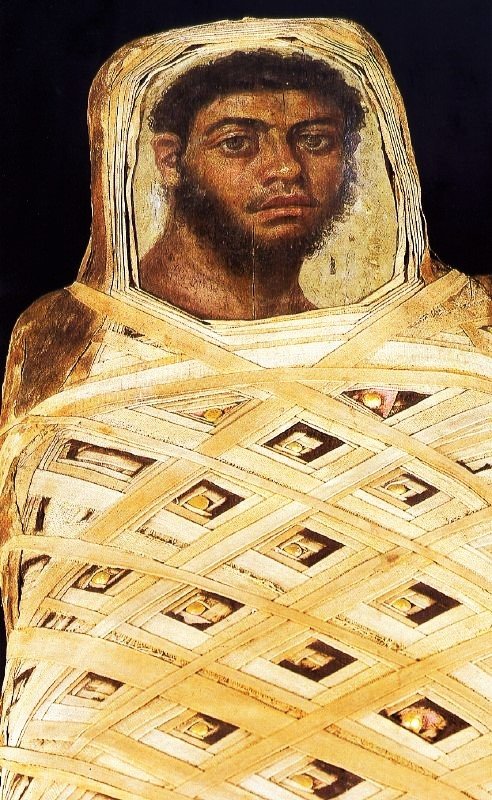

This site, at the entrance to the Fayum oasis, was the place of the pyramid and mortuary temple of the Middle Kingdom pharaoh Amenemhat III (ca. Strong ties to the traditional Pharaonic religion can also be deduced from the popularity of Hawara as a burial place for panel portrait mummies. Placed over the faces and fastened into the linen wrappings of Egyptian mummies, the portraits demonstrate clearly that the seemingly Greco-Roman individuals represented in the paintings adhered to traditional Egyptian beliefs about the afterlife. Seen in their original context, however, the character of the painted portraits changes. Taken by themselves, the encaustic panel portraits appear to have no links with Pharaonic Egypt. None of these styles and fashions had any connection with traditional Egyptian customs. The clothing, hairstyles, and jewelry worn by the individuals represented in the panel portraits display fashions that were prevalent throughout the Roman Empire-most likely under strong influences from the imperial court-but also incorporate special eastern Mediterranean idiosyncrasies, such as a profusion of curls in some of the female hairdos. Indeed, since practically no panel paintings from the Greek world have been preserved, the mummy portraits-conserved by Egypt's arid climate-are the only examples of an art form that ancient literary sources place among the highest achievements of Greek culture. In their artistic style and technique, the portraits on wood panels followed the Greek painting tradition of depicting the subject in three-quarter view, with a single light source casting realistic shadows and highlights on the face. The truly multicultural population in the cities of Roman Egypt provided a fertile ground for phenomena such as the painted panel portraits on mummies.

The beneficiaries of such advantageous economic conditions were-for a while, at least-not only the Roman rulers but also a rich upper class of landowners and merchants in Egypt itself, a class that consisted of a diverse mixture of indigenous Egyptians and descendants of people from countries all around the eastern Mediterranean who had settled in the Nile Valley and oases (such as the Fayum) during the rule of the Ptolemies (332–30 B.C.). Egypt's deserts furnished a great variety of minerals, ores, and hard stones.

Moreover, the city of Alexandria exported Egypt's manifold manufactured goods-such as papyrus, glass, and other luxury articles-while the Nile and the desert routes that linked to the Red Sea provided trade connections with inner Africa, the Arabian Peninsula, and India. Rome's interest in Egypt was, to a large degree, economic: the fertile lands along the Nile were capable of producing a rich surplus of foodstuffs, especially grain, that became essential in feeding the populace of the city of Rome. The importance of the new province was expressed by its special status as the personal estate of the emperor, ruled by a prefect.
#Fayum portraits full#
Accompanied by examples of beautiful mummy coverings and masks, jewelry, funerary stelae, and related works from the same period, the exhibition contextualizes the portraits in the complex culture of Roman Egypt and explores the full range of mummy portrait techniques-encaustic and tempera on wood panels, tempera paintings on linen, and painted masks and coffins of plaster and cartonnage.Įgypt became part of the Roman Empire after the battle of Actium and the death of Cleopatra VII (30 B.C.). With their direct full gaze and strong presence, these portraits, at once Greco-Roman in their painting style and intrinsically Egyptian in their purpose, bring the inhabitants of ancient Egypt before us with compelling immediacy.īased on a similar exhibition at the British Museum in 1997, Ancient Faces presents approximately seventy of the finest Fayum portraits, drawn from museums throughout Europe and the United States. Until recently almost entirely overlooked by scholars and the public alike, these are startlingly realistic portraits of men and women of all ages. Called Fayum portraits, these images were sometimes placed over the heads of mummies. From the first to third century A.D., the art of painted panel portraits flourished in Roman Egypt.


 0 kommentar(er)
0 kommentar(er)
